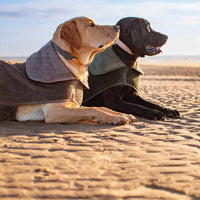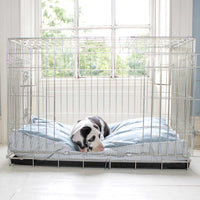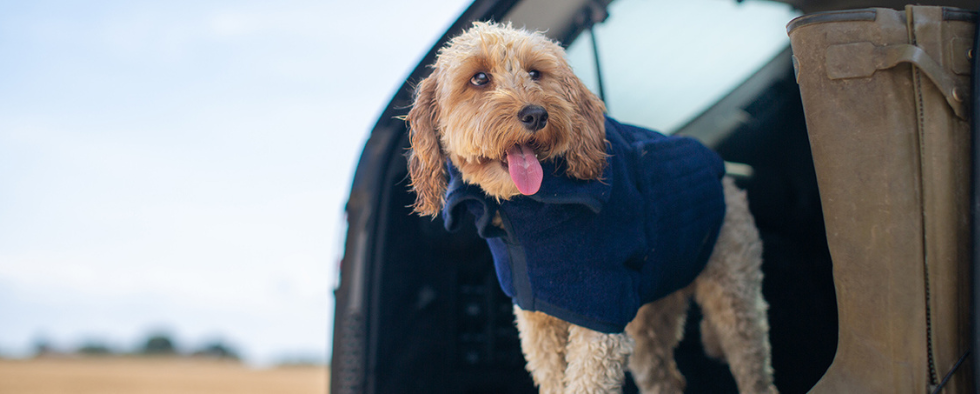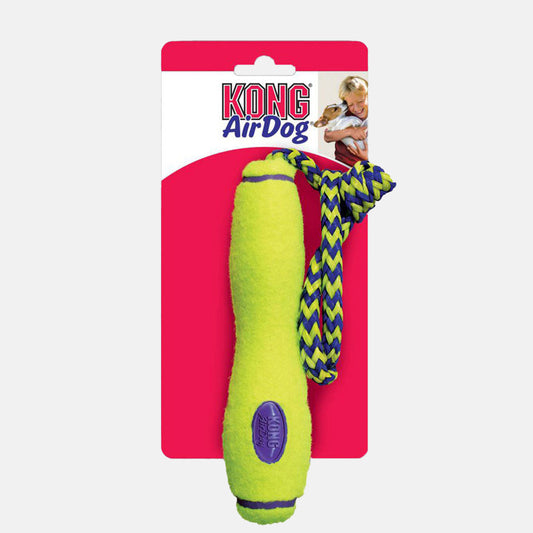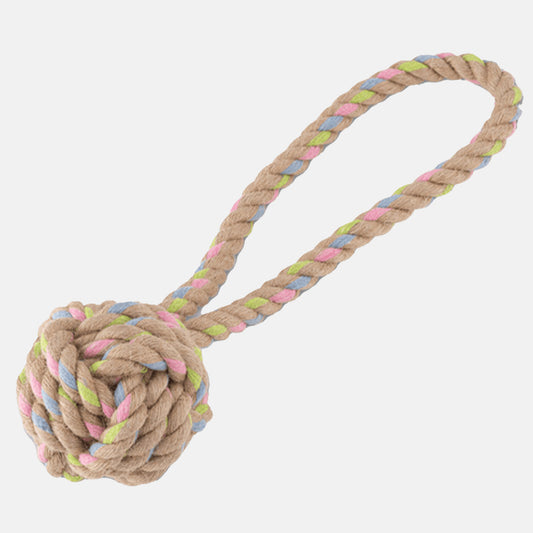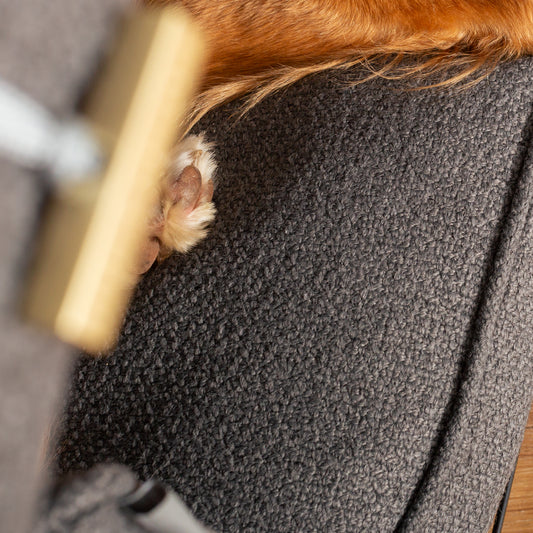If you're anything like us, as soon as the weather gets warmer you're looking for fun days out to go on with your dog. One of our favourite dog-friendly trips is to the beach, however, not all beaches are geared up day trips with your dogs. Here we look our top ten dog-friendly beaches in the UK so you can plan your next seaside adventure with your dog.
Our Top 10 Beaches For Dog Walking
1. Holkham Bay, Norfolk

A beautiful sandy beach on the Norfolk coast, Holkham is perfect for a walk with your dog. In fact, there are miles of unspoiled coastline here to enjoy a long adventure with your canine family members. At low tide, the beach stretches a mile from the entrance to the sea so there's plenty of space for your dogs to run around. There's a lot of nature to spot including birds and seals.
The beach has such a peaceful feel with the nature reserve that runs alongside the sand and the sunsets are beautiful.
2. Lunan Bay, Scotland
Lunan Bay has a lot to offer including a gorgeous cliff-lined edge and endless sandy beaches. As well as a great opportunity for a good walk, there are other things to see too, including a cave, the ruins of Red Castle and a bird hide for the ornithologists amongst you. You may even catch a glimpse of dolphins in the water on a clear day. The beach is also popular with surfers and horse riders.
This is a great option if you're looking for a dog-friendly beach trip, it has free parking and the local diner is also dog friendly so why not stop by for a coffee and a cake after your walk?
3. Freshwater West Beach, Wales

A wide, open sandy beach that is popular with surfers, you wouldn't be wrong for thinking that Freshwater West Beach looks familiar. The beach has actually been used in several films, from Ridley Scott's Robin Hood to Harry Potter and the Deathly Hallows, it's definitely worth a visit especially if you're a film buff!
Freshwater West Beach is dog friendly all year round and perfect for your next coastal adventure with your dog.
4. Whitely Bay, North Tyneside
In the North of England sits Whitley Bay. A blue flag award-winning beach punctuated by St Mary’s Lighthouse, it is perfect for dog walks and picnics, there are also plenty of dog-friendly cafes and pubs around if you want to stop for a drink after your dog walk. Dogs are allowed on the section north of Panama Gardens all year round and the rest of the beach between September and May.
5. Dunster Beach, Somerset

Located on the edge of Exmoor is Dunster Beach; a wide beach of sand and pebble. It’s a super popular choice for walkers as the 25-mile West Somerset Coastal path runs through it. So not only is this the ideal beach for a casual stroll and a paddle, but is ideal if you’re a walking enthusiast and looking for a more adventurous walk with your dog. There are plenty of car parks here for your visit, but it’s also possible to drive right up the beach in places too - just take note of how busy it is as it’s a popular spot.
6. Climping, Sussex
A quiet rural beach on the Sussex beach. Climping (or Atherington as it’s also known) is predominantly shingle with a good stretch of sand at low tide. The beach has been identified as a “Site of Special Scientific Interest” so some of the sand dunes are now fenced off to help prevent erosion
7. Sandymouth, Cornwall

This is a really beautiful cliff-lined beach that sits in-between Bude and Morwenstow, in Cornwall. It’s a dramatic landscape and perfect for an afternoon out. A predominantly pebble beach with sand exposed as the sea retreats, there is something here for everyone; if you’re looking for a more adventurous ramble with your canine companions you might like to try a walk along the South West Coast Path that runs along the cliff top. For a more relaxed day out, a stroll along the water’s edge and a paddle might be more suitable.
There are lots of rock pools to look for creatures in, cliffs and caves to explore, there really is something for everyone! Parking is free for National Trust Members as well!
8. Theddlethorpe, Lincolnshire
Theddlethorpe is one of our favourites here at L&L, the dunes here are designated a National Nature Reserve and it's simply stunning. The tide never comes fully in so you don't have to worry about the water and it's one of the quieter beaches in the area. The beach is definitely one for nature lovers with its unspoiled sands and salt marshland, there are so many different habitats here for animals to thrive in!
9. Embleton Bay, Northumberland

The views in Embleton Bay are stunning, the dramatic coastline has a rugged, romantic feel to it. Embleton Bay is great for both sightseeing and dog walks, the 14th-century Dunstanburgh Castle ruins are at one end with miles of golden sandy beaches snaking up to them
10. Three Cliffs Bay, Gower Peninsula
These are one of the most photographed beaches in Britain and it's easy to see why! It's spectacularly beautiful with a freshwater stream running through it and lined with sand dunes, it's one of the quieter beaches in the area. There's a 400m walk to get onto the beach but we promise it's worth it!
Things to Remember When Taking Your Dog to the Beach
Research before you go
Every beach is different and so researching the spot you intend to visit is really important. Some beaches will have certain restrictions such as certain times of the year when dogs might not be allowed. Some may ask that your dog is on a lead at all times whilst others will be more relaxed. Be prepared so you can make the most of your day.
Take provisions
There are some obvious items you should take such as your dogs walking set and some poo bags, but also think about what else you might need. If you’re going to be out for an extended period you might take some drinking water and a pet travel bowl for them. A drying coat might be an essential if your dog is a water lover and is likely to venture into the sea. You might take some outdoor dog toys to add some playtime fun to the day trip. If you’re planning a full day out with a long car journey, maybe invest in a good travel bag for your dog with travel feeding bowls and accessories. That way your dog can join in with a picnic. Our other beach essential is a first aid kit, the Charlie The Vet kits are one of our travel essentials!
Be aware of other people
If there are a few people about and your dog is likely to run off, then you may consider keeping them on a lead for the whole time you’re at the beach, even if it’s not a requirement of the beach you’re visiting. Practicing good pet etiquette makes the time enjoyable for both you, your pets and everyone else on the beach. Longline leads are great for giving your pets the freedom to roam without you having to worry about where they are wondering off to.
Pick up your dog’s waste
You may think it less important to pick up your dog’s poo when on the beach; it can be buried in the sand or washed away by the sea, but that’s not the case. It’s just as important to pick up your dog’s mess here as in any other location. Dog waste contains harmful bacteria and causes harm to sea life, children playing in the sea and people walking on the beach. Always clean up after your dog!
Be mindful of the local wildlife
You may see all kinds of wildlife depending on the particular coastline you are visiting. If your dog has a tendency to chase birds or other animals it may be best to keep them on their lead. It isn’t fair for other animals to be chased unnecessarily. In some ares there will be restricted areas for nesting and endangered wildlife. Whilst you may know not to enter, your wandering dog won’t know the difference. Take care and control your dog. You want the day to be pleasant for all, human and animal alike.
Be mindful of heatstroke
If you're planning to go on a warmer day make sure you consider whether it's too warm for your dog. It will typically be a little cooler on the beach but just check the forecast before you go to keep your dog safe!


























